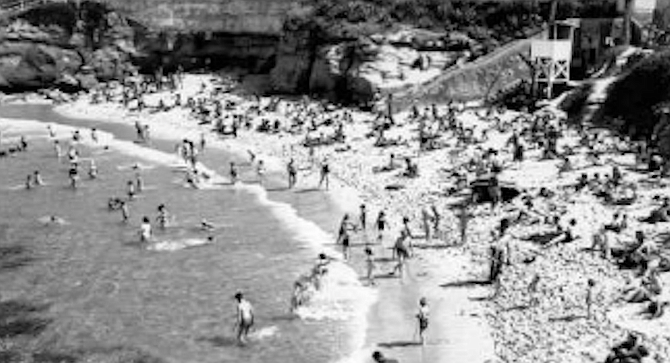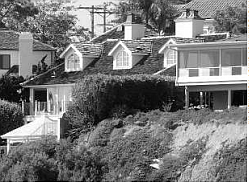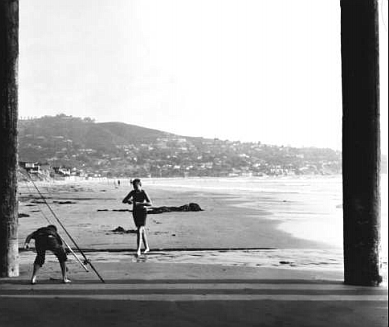 Facebook
Facebook
 X
X
 Instagram
Instagram
 TikTok
TikTok
 Youtube
Youtube


MAX MILLER arrived in San Diego in the mid-1920s when he was in his mid-20s. He went to work as a reporter for the now long-defunct San Diego Sun. In 1932 he wrote the book that made him famous. He called the book I Cover the Waterfront. It was published in 1932 and became a best-seller and allowed its author to quit the newspaper. From 1932 until his death at 68 in 1967, Miller wrote almost one book per year. None of those books, alas, ever was as popular as was I Cover the Waterfront.

The Town with the Funny Name, whose first three chapters are printed in this issue, was first published in 1948 (a year after the La Jolla Playhouse was founded by Gregory Peck, Dorothy McGuire, and Mel Ferrer). It was Miller’s 19th book. The town, of course, is La Jolla, where Miller lived for many years. When he died a few days after Christmas, the Union noted in its obituary that “Miller did most of his writing in his home overlooking the sea at 5930 Camino de la Costa, La Jolla. His body was found in his room there early yesterday by his wife, Margaret, whom he married August 23, 1927.” The Millers’ La Jolla house stood a block away from La Jolla’s other famous writing fellow — Raymond Chandler. The two men sometimes played tennis together.

Margaret and Max Miller, over five decades, regularly socialized with Everett Gee Jackson and Eileen Jackson and a group that included many local artists. Mr. Jackson was a painter and a professor at San Diego State University. Mrs. Jackson was a newspaper reporter and society columnist. At the time of Max Miller’s death, Eileen Jackson was a San Diego Union columnist. She told the obit writer, about Miller, “I remember how handsome and colorful he was.”
Handsome, he certainly was, and colorful, too. Parties sometimes grew wild and the humor, ribald. Miller’s obituary mentioned, “One of Miller’s hobbies was playing drums. The last time he played them was Christmas Eve at a party at the home of the Jacksons. The drums are still by the Christmas tree at the Jackson home.”
I spoke recently with the Jacksons’ daughter, Jerry Williamson, author of the superb biography of her mother — Eileen. She told me that her father had once said that Miller had “the soul of a poet.” Mrs. Williamson confessed that when she was a child Miller terrified her. The Millers were childless, and Mrs. Williamson later would learn that Max Miller “felt nervous around children.” By the time Mrs. Williamson was out of high school, she and Miller had become friends. She adored him, she said. He was very funny, and he and her father were notorious pranksters. She recalled a party at which her father introduced Miller to a society matron as one of the wine-making Christian Brothers. “Do you crush the grapes with bare feet?” the lady asked “Brother Max.” “No,” the faux-monk answered, “we crush the grapes with naked women.” Mrs. Williamson, born in 1928, remembered Mr. Miller’s La Jolla book. Published after he came home from service in the Navy (he served in World Wars I and II and in Korea), The Town with the Funny Name is full of bittersweet reflections. The San Francisco Chronicle’s reviewer wrote that he’d read everything by Miller since I Cover the Waterfront. The reviewer added, “This latest volume contains a quality of truly adult detachment we don’t recall detecting in his work before. We think it may be directly traceable to his Navy experience in World War II.” (Nineteen forty-eight was a big year for big books about the war — Norman Mailer’s Naked and the Dead, Dwight D. Eisenhower’s Crusade in Europe, and Irwin Shaw’s Young Lions.)
The New Yorker reviewer wrote, about the book, “Charming writing about the town of La Jolla, California, and its inhabitants, and about any number of other things — life, death, the sea, cocktail parties, and so on — that Mr. Miller has given some thought to. Fairly maddening.”
Who knows now, 50-some years later, what the magazine meant by “Fairly maddening.” The San Francisco Chronicle’s reviewer found the book “fey,” and what he meant by “fey,” I think, is “otherworldly, magical.” I think, too, that he is referring to this “adult detachment.” This reviewer’s assessment of the book’s 38 essays (which vary in length from a few pages to a dozen) is that the essays “range from faintly bawdy but civilized anecdotes to nature appreciations which would not have to blush beside Thoreau.”
The Saturday Review of Literature’s Courtlandt Canby liked Miller’s book. “The essay is almost a lost art today; it is refreshing, therefore, to run across a book like this, which is readable, whimsically humorous, unpretentious, and pleasantly reflective.… Miller has a trick of throwing in little stories or digressions, often whimsical in a Saroyanesque manner…and these stories and digressions make up the real charm of the book.”
In these essays, the reader will see La Jolla as the town was just after World War II. La Jolla’s population was 5500 in 1940, and a martini at the Marine Room could be had for 35 cents; in 1950 the population had doubled to 10,108 and Putnam’s on Prospect wanted $1.25 for that chilled glass of gin and vermouth. The reader will meet various characters who are presented by their author as La Jolla regulars. There’s Perky the fisherman and the lanky and brightly clothed (and unclothed) Mrs. Billings and the dubious Willie-the-Arranger. These La Jolla regulars fish and swim and act up at cookouts and cocktail parties. Mrs. Billings well may remind you of the zany ladies seen in the New Yorker’s cartoons at along about the same time that the magazine described Max Miller’s La Jolla book as “Charming writing” and “Fairly maddening.”
I asked Mrs. Williamson if her old friend Max Miller tinkered together his Mrs. Billings and his Perky and others from pieces of real-life La Jollans. She laughed. He did, oh yes.
That San Francisco reviewer who was such a Max Miller fan advised potential readers of The Town with the Funny Name that “this is not a volume to be read in haste. It should be placed on your shelves along with those other books to which you return for rich and rewarding items again and again.”
Over the next few months, the Reader will publish chapters from The Town with the Funny Name. The late Howard Chernoff, in his day a big man in San Diego media circles, was Max Miller’s friend for 20-plus years. Chernoff told the Union’s obituary writer that Miller was “San Diego’s first big-league literary figure and one of the finest of America’s philosophical essayists.” Chernoff said that he believed that “Miller is one of those writers who will be rediscovered, perhaps again and again. Someday the best of his lesser-known works may be as popular as Waterfront.” The Reader hopes that republication of this lesser-known work will help to hasten Max Miller’s rediscovery.



MAX MILLER arrived in San Diego in the mid-1920s when he was in his mid-20s. He went to work as a reporter for the now long-defunct San Diego Sun. In 1932 he wrote the book that made him famous. He called the book I Cover the Waterfront. It was published in 1932 and became a best-seller and allowed its author to quit the newspaper. From 1932 until his death at 68 in 1967, Miller wrote almost one book per year. None of those books, alas, ever was as popular as was I Cover the Waterfront.

The Town with the Funny Name, whose first three chapters are printed in this issue, was first published in 1948 (a year after the La Jolla Playhouse was founded by Gregory Peck, Dorothy McGuire, and Mel Ferrer). It was Miller’s 19th book. The town, of course, is La Jolla, where Miller lived for many years. When he died a few days after Christmas, the Union noted in its obituary that “Miller did most of his writing in his home overlooking the sea at 5930 Camino de la Costa, La Jolla. His body was found in his room there early yesterday by his wife, Margaret, whom he married August 23, 1927.” The Millers’ La Jolla house stood a block away from La Jolla’s other famous writing fellow — Raymond Chandler. The two men sometimes played tennis together.

Margaret and Max Miller, over five decades, regularly socialized with Everett Gee Jackson and Eileen Jackson and a group that included many local artists. Mr. Jackson was a painter and a professor at San Diego State University. Mrs. Jackson was a newspaper reporter and society columnist. At the time of Max Miller’s death, Eileen Jackson was a San Diego Union columnist. She told the obit writer, about Miller, “I remember how handsome and colorful he was.”
Handsome, he certainly was, and colorful, too. Parties sometimes grew wild and the humor, ribald. Miller’s obituary mentioned, “One of Miller’s hobbies was playing drums. The last time he played them was Christmas Eve at a party at the home of the Jacksons. The drums are still by the Christmas tree at the Jackson home.”
I spoke recently with the Jacksons’ daughter, Jerry Williamson, author of the superb biography of her mother — Eileen. She told me that her father had once said that Miller had “the soul of a poet.” Mrs. Williamson confessed that when she was a child Miller terrified her. The Millers were childless, and Mrs. Williamson later would learn that Max Miller “felt nervous around children.” By the time Mrs. Williamson was out of high school, she and Miller had become friends. She adored him, she said. He was very funny, and he and her father were notorious pranksters. She recalled a party at which her father introduced Miller to a society matron as one of the wine-making Christian Brothers. “Do you crush the grapes with bare feet?” the lady asked “Brother Max.” “No,” the faux-monk answered, “we crush the grapes with naked women.” Mrs. Williamson, born in 1928, remembered Mr. Miller’s La Jolla book. Published after he came home from service in the Navy (he served in World Wars I and II and in Korea), The Town with the Funny Name is full of bittersweet reflections. The San Francisco Chronicle’s reviewer wrote that he’d read everything by Miller since I Cover the Waterfront. The reviewer added, “This latest volume contains a quality of truly adult detachment we don’t recall detecting in his work before. We think it may be directly traceable to his Navy experience in World War II.” (Nineteen forty-eight was a big year for big books about the war — Norman Mailer’s Naked and the Dead, Dwight D. Eisenhower’s Crusade in Europe, and Irwin Shaw’s Young Lions.)
The New Yorker reviewer wrote, about the book, “Charming writing about the town of La Jolla, California, and its inhabitants, and about any number of other things — life, death, the sea, cocktail parties, and so on — that Mr. Miller has given some thought to. Fairly maddening.”
Who knows now, 50-some years later, what the magazine meant by “Fairly maddening.” The San Francisco Chronicle’s reviewer found the book “fey,” and what he meant by “fey,” I think, is “otherworldly, magical.” I think, too, that he is referring to this “adult detachment.” This reviewer’s assessment of the book’s 38 essays (which vary in length from a few pages to a dozen) is that the essays “range from faintly bawdy but civilized anecdotes to nature appreciations which would not have to blush beside Thoreau.”
The Saturday Review of Literature’s Courtlandt Canby liked Miller’s book. “The essay is almost a lost art today; it is refreshing, therefore, to run across a book like this, which is readable, whimsically humorous, unpretentious, and pleasantly reflective.… Miller has a trick of throwing in little stories or digressions, often whimsical in a Saroyanesque manner…and these stories and digressions make up the real charm of the book.”
In these essays, the reader will see La Jolla as the town was just after World War II. La Jolla’s population was 5500 in 1940, and a martini at the Marine Room could be had for 35 cents; in 1950 the population had doubled to 10,108 and Putnam’s on Prospect wanted $1.25 for that chilled glass of gin and vermouth. The reader will meet various characters who are presented by their author as La Jolla regulars. There’s Perky the fisherman and the lanky and brightly clothed (and unclothed) Mrs. Billings and the dubious Willie-the-Arranger. These La Jolla regulars fish and swim and act up at cookouts and cocktail parties. Mrs. Billings well may remind you of the zany ladies seen in the New Yorker’s cartoons at along about the same time that the magazine described Max Miller’s La Jolla book as “Charming writing” and “Fairly maddening.”
I asked Mrs. Williamson if her old friend Max Miller tinkered together his Mrs. Billings and his Perky and others from pieces of real-life La Jollans. She laughed. He did, oh yes.
That San Francisco reviewer who was such a Max Miller fan advised potential readers of The Town with the Funny Name that “this is not a volume to be read in haste. It should be placed on your shelves along with those other books to which you return for rich and rewarding items again and again.”
Over the next few months, the Reader will publish chapters from The Town with the Funny Name. The late Howard Chernoff, in his day a big man in San Diego media circles, was Max Miller’s friend for 20-plus years. Chernoff told the Union’s obituary writer that Miller was “San Diego’s first big-league literary figure and one of the finest of America’s philosophical essayists.” Chernoff said that he believed that “Miller is one of those writers who will be rediscovered, perhaps again and again. Someday the best of his lesser-known works may be as popular as Waterfront.” The Reader hopes that republication of this lesser-known work will help to hasten Max Miller’s rediscovery.
Comments